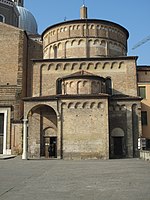Diocesan museum of Padua, Italy
Museums in PaduaReligious museums in Italy
The Diocesan museum of Padua displays arts and artifacts belonging to the Roman Catholic Diocese of Padua; it is housed in the 15th-century former bishop's residence or Palazzo Vescovile. The building, adjacent to the Cathedral of Padua, faces the Piazza del Duomo, can in the historic center of Padua, region of Veneto, Italy. Many of the works in the museum derive from the cathedral or from other diocesan churches, some suppressed and no longer extant. The collections date from the 9th to the 19th centuries. They are displayed on two separate floors and are ordered chronologically and by type.
Excerpt from the Wikipedia article Diocesan museum of Padua, Italy (License: CC BY-SA 3.0, Authors).Diocesan museum of Padua, Italy
Piazza del Duomo, Padua San Giuseppe
Geographical coordinates (GPS) Address Phone number Website Nearby Places Show on map
Geographical coordinates (GPS)
| Latitude | Longitude |
|---|---|
| N 45.4069039 ° | E 11.8722693 ° |
Address
Palazzo del Monte di Pietà
Piazza del Duomo 14
35149 Padua, San Giuseppe
Veneto, Italy
Open on Google Maps










